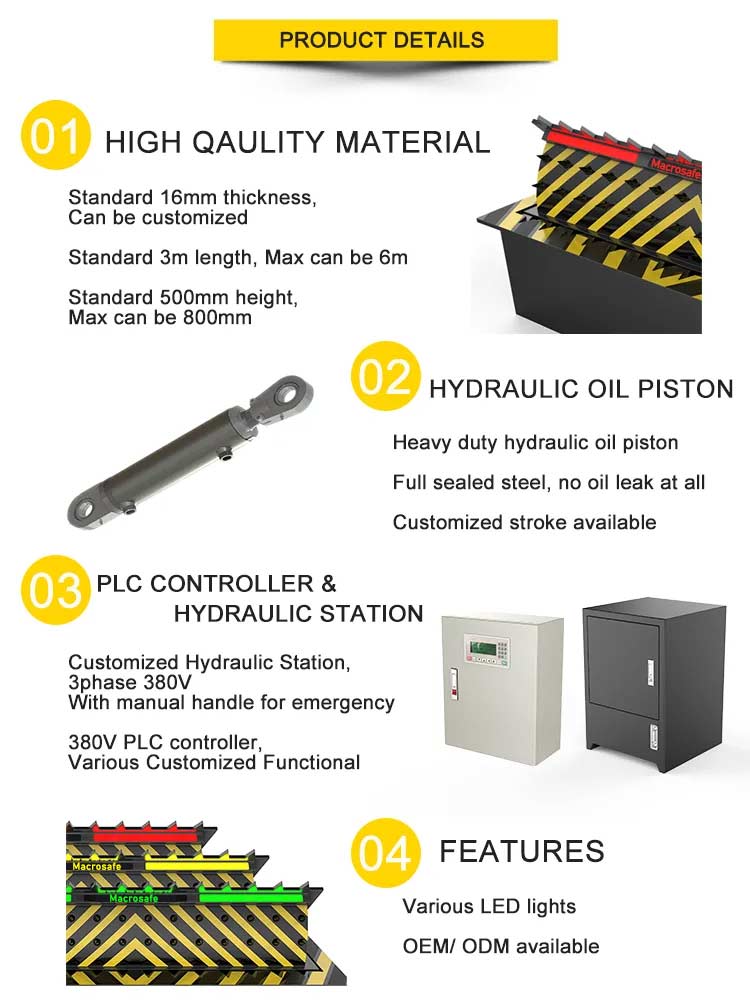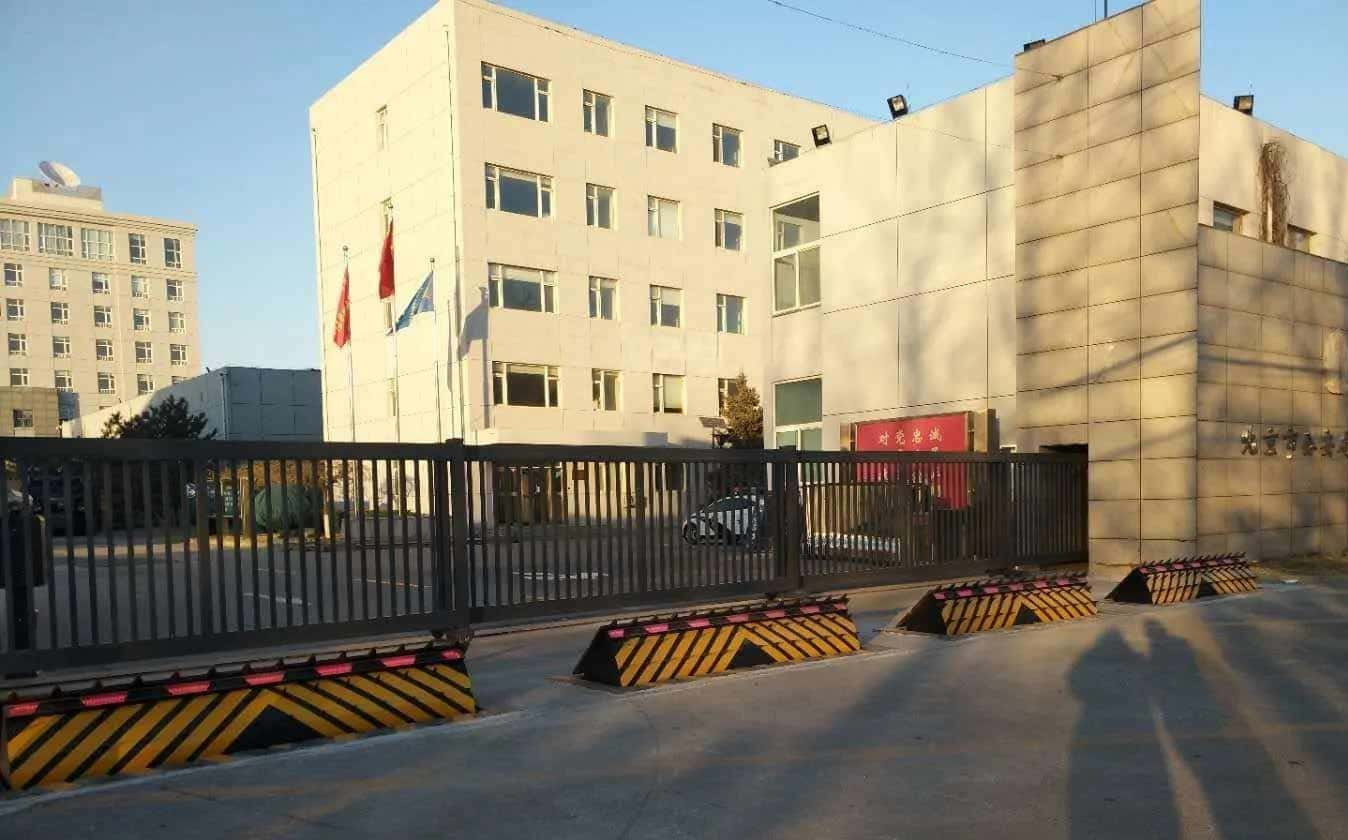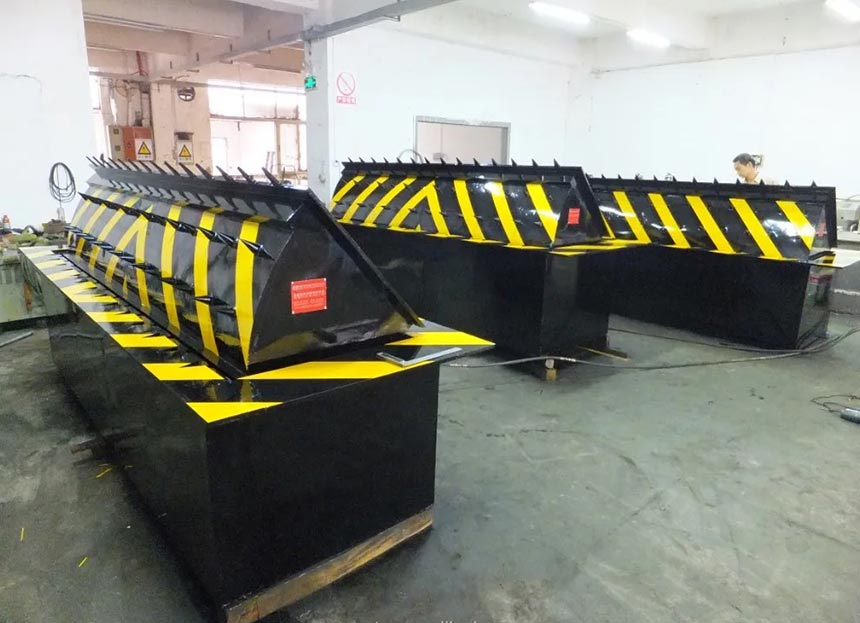What is road blocker?
Road blocker, is also called anti-terrorist roadblocker, street blockers and anti-ram barriers, which is used to control or restrict vehicle access to a particular area. It is designed to withstand high-impact collisions and are an effective deterrent against vehicle-based attacks.
 Road blockers are typically installed at entry and exit points of high-security facilities such as:
Road blockers are typically installed at entry and exit points of high-security facilities such as:
● Government buildings
● Embassies
● Military bases
● Airports
● Prisons
● Industrial sites
etc;
Unlike ordinary roadblocks, road blockers are made of steel, while ordinary roadblocks are generally made of plastic or concrete. The most important point is that they can be raised or lowered into place using a hydraulic or pneumatic system.
Road blockers are operated electronically and can be controlled by a variety of methods, including remote control, key-card access, or a central control room. When activated, the road blocker rises from the ground to create a physical barrier that prevents vehicles from entering the controlled area. Some road blockers are equipped with additional features such as warning lights and alarms, which can help to deter unauthorized access and alert security personnel in case of an intrusion.
2. What are the component of a road blocker?
Road blockers are a piece of technology used for controlling vehicular access to high-security areas such as government buildings or airports. Road blockers, also known as rising kerbs, are made up of various components with the primary function of blocking vehicular access to certain areas.
The road blocker consists of the following parts:
1. Hydraulic Power Unit (HPU): The HPU is the main component of a hydraulic road blocker. It consists of a hydraulic pump, an oil reservoir, and a set of control valves.
2. Barrier Segment: The barrier segment is the physical component of the road blocker that rises from the ground to create a barrier. It is made of high-strength steel and can withstand a significant amount of force.
3. PLC controller: The plc controller is used to control the road blocker. It is typically located in a security booth or control room and can be operated remotely.
4. LED lights: The LED lights on hydraulic road blockers serve as warning signals to drivers and pedestrians. These lights are typically located on the top of the barrier segment and can be seen from a distance.
5. Safety Features: Hydraulic road blockers are equipped with various safety features to prevent accidents and ensure smooth operation. These include safety pressure switches, emergency stop buttons, and safety barriers.

How does a road blocker work?
Macrosafe road blocker is mainly composed of three parts: main frame of road blocker, hydraulic transmission device and automatic inspection and control device. The whole machine is a steel structure, which is welded by thick plates and channel steel, and has strong load-bearing and anti-collision capabilities. Installing the device on the driveway can effectively restrict vehicle traffic.
The hydraulic transmission device uses the hydraulic system to drive the expansion and contraction of the oil cylinder, so that the roadblock machine can be lifted quickly. The automatic detection device can be equipped with remote control switches, leakage protection, and parameter setting panels in the duty room.
Factors to Consider Before Buying a Road Blocker: A Buyer's Guide
When considering purchasing road blockers, it is important to take several factors into account to ensure that the product meets the specific needs of your facility. Here are some factors to consider before buying road blockers:
About the design of road blocker
1. Is the road blocker a load-bearing structure? The road blocker with a non-load-bearing structure will rise at a certain angle after the vehicle is pressed on it after a period of use.
Macrosafe road blocker adopts national standard high-strength profiles and exclusive patented design, scientific mechanics two-way heavy vehicle impact and rolling defense structure, without deformation for many years!
2. Can the turning body of the road blocker withstand fatigue lifting? Focus on the design between the turning body of the barricade and the main structure? Many cheap road blockers on the market use simple hinges, which will definitely be deformed or even damaged within half a year!
The Macrosafe road blocker adopts a sliding shaft flip structure design, which supports high-intensity intensive lifting.
About the oil cylinder of road blocker:
1. Whether the lifting cylinder has a thick rod diameter and whether the cylinder body is made of high-strength alloy material
2. Is the oil seal made of imported materials? In case of poor sealing, high pressure and easy oil leakage
3. Is there a buffer device installed and muted when lifting to the end?
4. Is there an antifreeze heating device for the entire oil circuit in cold regions?
5. Is there a fixed protective device for the oil pipe and line?
Add-ons of road blockers
1. Is there an automatic switching design for main and backup dual oil circuits?
2. Is there any maintenance device designed without removing the barricade panel?
3. Is there a backup battery to ensure the normal operation of the road blocker in case of sudden power failure?
4. Is there a supporting voice and warning lights during the lifting process?
Integrate with other security systems
6. Multi-crossing roadblocks, whether it can be connected to the network and remotely controlled by an integrated platform management, whether it can be linked with other gates and vehicle detection systems, these must be taken into consideration when selecting road blockers.
 Other factors to consider before buying road blockers:
Other factors to consider before buying road blockers:
1. Purpose: Consider the purpose of the road blockers. Are they intended to prevent vehicle access to a high-security area or to provide traffic control at an entry point? So decide to buy road blocker with spikes or without spikes.
2. Size: Consider the size of the road blockers. The size should be appropriate for the size of the vehicles that will be using the entry point. For example, if trucks or other large vehicles will be entering the area, the road blockers should be large enough to accommodate them.
|
Model
|
Dimensions
|
Flip height
|
Remark
|
|
MS-RB01
|
L3000*W1050*H600mm
|
450-600mm
|
Size can be customized
|
|
MS-RB02
|
L4000*W1050*H600mm
|
450-600mm
|
Size can be customized
|
|
MS-RB03
|
L5000*W1050*H600mm
|
450-600mm
|
Size can be customized
|
3. Strength and Durability: Consider the strength and durability of the road blockers. They should be able to withstand high-impact collisions and remain functional in harsh weather conditions.
4. Control Options: Consider the control options for the road blockers. Will they be controlled manually or automatically? The control options will depend on the intended use of the road blockers and the level of security required.
5. Maintenance: Consider the maintenance requirements for the road blockers. They should be easy to maintain and repair, with minimal downtime or disruption to the facility.
6. Cost: Consider the cost of the road blockers. They should be affordable and provide value for money while meeting the specific needs of the facility.
7. Local Regulations: Consider any local regulations or requirements for road blockers. These may include size restrictions, safety requirements, and installation guidelines.
By taking these factors into account, you can select road blockers that meet the specific needs of your facility and provide effective security and traffic control.
Where to buy road blocker?
Customers can choose and customize road blockers according to their specific needs for the application site. Feel free to contact us if you need customized road blocker products. For more information, you can also click on the following products.
Road blocker prices: how much does road blocker cost?
The cost of a hydraulic road blocker can vary depending on the manufacturer, model, and features. Generally, a standard hydraulic road blocker can cost anywhere from $1,500 per meter to $2,500 per meter.
Where Can You buy Road Blocker?
 When it comes to purchasing road blockers, Macrosafe is the best choice for a number of reasons.
When it comes to purchasing road blockers, Macrosafe is the best choice for a number of reasons.
Highest Qualtiy
Firstly, our road blockers are designed and built to the highest standards of quality and reliability, ensuring that they provide maximum security and protection to your facility.
Best Material
We use only the best materials, and our products are rigorously tested to ensure that they meet all relevant safety standards.
Professional Solution
Additionally, our team of experts will work closely with you to understand your specific needs and requirements, and will provide you with tailored solutions that are both effective and cost-efficient.
Excellent Customer Service
Finally, we offer excellent customer service and support, ensuring that you get the most out of your investment in our products.
So if you're looking for the best road blockers on the market, look no further than Macrosafe. Welcome to contact us.
How to Install Street Blockers?
Make sure all tools and equipment are ready before installing hydraulic street blockers.
Equipment and tools needed:
- Screwdrivers
- Wrenches
- Hydraulic pump unit
- High-pressure hydraulic hoses
- Concrete drill
- Concrete screws
- Bolts
- Nuts
- Gravel and sand
- Concrete mix

The installation steps are as follows:
1. Determine the location where the street blockers will be installed. Ensure that there is enough clearance for the blocker to deploy, and that there is a stable foundation that can support the blocker's weight.
2. Prepare a large, deep hole for the hydraulic street blocker using a concrete drill.
3. Insert the hydraulic street blocker into the hole and fill the area around it with gravel and sand. Compact the gravel and sand by tapping it down evenly with a heavy object.
4. Connect the high-pressure hydraulic hoses to the hydraulic unit, using the appropriate wrenches to tighten the connections. Ensure that the hoses are not kinked or twisted, and that they have been routed to the location where the hydraulic road blocker will be installed.
5. Position the hydraulic street blocker in place above the hole where the hydraulic unit is installed. Level the blocker and make sure it is oriented correctly.
6. Secure the hydraulic road blocker to the foundation using concrete screws, bolts, and nuts. Tighten them using the appropriate wrenches.
7. Position the control panel and connect the wiring from the hydraulic unit to the control panel. Follow the manufacturer's instructions to connect the wiring correctly.
8. Mix the concrete mix as per manufacturer's instructions and fill the space between the hydraulic road blocker and the hole using the concrete mix. Make sure the mix is level and free of air pockets. Dry the concrete for the recommended amount of time.
9. Test the hydraulic street blocker to ensure that it is working correctly. The hydraulic road blocker should be tested several times to ensure that it is working properly.
10. After installation, clean the installation area thoroughly.
.
More Articles:
Overview of Retractable Bollards: Types, Functions, Cost & Install
How much is a turnstile gate? | Best Buying Guide
Top 5 Tripod Turnstiles in 2024 | Turnstile Buying Guide
Why turnstiles are perfect access control solutions for gyms?
TOP 5 Most Popular Flap Barrier Gates for Entrance Control
Compared with ordinary turnstiles, what are the advantages of glass turnstiles?
What are the types of half-height turnstiles?
Top 9 Benefits of Turnstile Barrier Gate for Your Business
8 Tips For Choosing Best Swing Barriers in 2023
Quick Installation of Speed Gate | 2024 Lastest Guide




